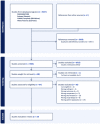Patient-reported outcome measures in physical therapy practice for neck pain: an overview of reviews
- PMID: 37782344
- PMCID: PMC10545655
- DOI: 10.1186/s41687-023-00637-0
Patient-reported outcome measures in physical therapy practice for neck pain: an overview of reviews
Abstract
Background: Understanding which patient-reported outcome measures are being collected and utilized in clinical practice and research for patients with neck pain will help to inform recommendations for a core set of measures that provide value to patients and clinicians during diagnosis, clinical decision-making, goal setting and evaluation of responsiveness to treatment. Therefore, the aim of this study was to conduct a review of systematic reviews using a qualitative synthesis on the use of patient-reported outcome measures (PROMs) for patients presenting with neck pain to physical therapy.
Methods: An electronic search of systematic reviews and guideline publications was performed using MEDLINE (OVID), Embase (Elsevier), CINAHL Complete (EBSCOhost), and Web of Science (Clarivate) databases to identify reviews that evaluated physical therapy interventions or interventions commonly performed by a physical therapist for individuals with neck pain and included at least one patient-reported outcome measure. The frequency and variability in which the outcome measures were reported among the studies in the review and the constructs for which they measured were evaluated. The evaluation of a core set of outcome measures was assessed. Risk of bias and quality assessment was performed using A Measurement Tool to Assess systematic Reviews 2.
Results: Of the initial 7,003 articles, a total of 37 studies were included in the final review. Thirty-one PROMs were represented within the 37 reviews with eleven patient-reported outcome measures in three or more reviews. The eleven PROMs assessed the constructs of disability, pain intensity, psychosocial factors and quality of life. The greatest variability was found amongst individual measures assessing psychosocial factors. Assessment of psychosocial factors was the least represented construct in the included studies. Overall, the most frequently utilized patient reported outcome measures were the Neck Disability Index, Visual Analog Scale, and Numeric Pain Rating Scale. The most frequently used measures evaluating the constructs of disability, pain intensity, quality of life and psychosocial functioning included the Neck Disability Index, Visual Analog Scale, Short-Form-36 health survey and Fear Avoidance Belief Questionnaire respectively. Overall risk of bias and quality assessment confidence levels ranged from critically low (2 studies), low (12 studies), moderate (8 studies), and high (15 studies).
Conclusion: This study identified a core set of patient-reported outcome measures that represented the constructs of disability, pain intensity and quality of life. This review recommends the collection and use of the Neck Disability Index and the Numeric Pain Rating Scale or Visual Analog Scale. Recommendation for a QoL measure needs to be considered in the context of available resources and administrative burden. Further research is needed to confidently recommend a QoL and psychosocial measure for patients presenting with neck pain. Other measures that were not included in this review but should be further evaluated for patients with neck pain are the Patient Reported Outcomes Measurement Information System (PROMIS) Physical function, PROMIS Pain Interference and the Optimal Screening for Prediction of Referral and Outcome Yellow Flag (OSPRO-YF) tool.
Keywords: Neck pain; Outcomes; Patient-reported outcome measures.
© 2023. International Society for Quality of Life Research (ISOQOL).
Conflict of interest statement
The authors declare that they have no competing interests.
Figures



References
-
- Coles TM, Curtis LH, Boulware LE. Measuring Health Prim Care. 2019;46:485–491. - PubMed
-
- Stefanovitch-Lawbuary N, Amirfeyz R, Lovell R, Bannister G. Reliability and responsiveness of patient-reported outcome measures of Neck disability to physical therapy: comparison of the Copenhagen, Northwick Park, and Neck Bournemouth Questionnaires and the Neck Disability Index. J Manipulative Physiol Ther. 2019;42:104–107. doi: 10.1016/j.jmpt.2019.03.007. - DOI - PubMed
Publication types
MeSH terms
LinkOut - more resources
Full Text Sources
Medical

